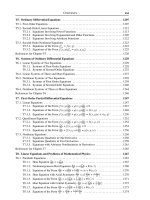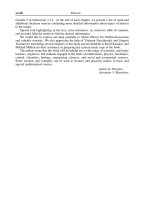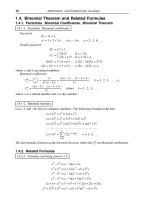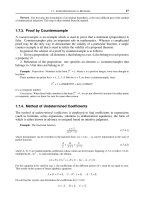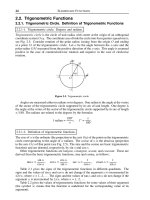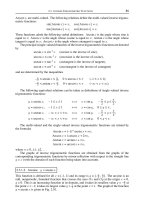Handbook of mathematics for engineers and scienteists part 138 docx
Bạn đang xem bản rút gọn của tài liệu. Xem và tải ngay bản đầy đủ của tài liệu tại đây (375.49 KB, 7 trang )
17.5. FUNCTIONAL EQUATIONS WITH SEVERAL VARIABLES 927
Remark. For the sake of analysis, it is sometimes convenient to choose suitable values of the parameter
a in order to simplify system (17.5.3.5).
Example. Consider the equation
f(x + y)+f(x – y)=2f(x)cosy.(17.5.3.8)
This equation holds as identity for y = 0 and any f(x).
Substituting (17.5.3.4) into (17.5.3.8), we get
f(t)+f(–t)=2C
1
cos t,
f(t + 2a)+f(t)=2f(t + a)cosa,
f(t + 2a)+f(–t)=2C
2
cos(t + a),
(17.5.3.9)
where C
1
= f(0), C
2
= f(a).
System (17.5.3.9) becomes much simpler for a = π/2. In this case, cos a = 0 and the function f(t + a)
is “dropped” from the equations; summing up the first two equations term by term and subtracting the third
equation from the resulting relation, we immediately find a solution of the functional equation (17.5.3.8) in the
form
f(t)=C
1
cos t + C
2
sin t. (17.5.3.10)
Verification shows that the function (17.5.3.10) is indeed a solution of the functional equation (17.5.3.8).
4
◦
. Now consider a functional equation more general than (17.5.3.1),
Φ
f(x), f (y), f(x + y), f(x – y), x, y
= 0.(17.5.3.11)
Letting y = 0,weget
Φ
f(x), a, f(x), f(x), x, 0
= 0,(17.5.3.12)
where a = f(0). If the left-hand side of this relation does not vanish identically for all f(x),
then it can be resolved with respect to f(x). Then, inserting an admissible solution f(x)
into the original equation (17.5.3.11), we fi nd possible values of the parameter a (there are
cases in which the equation has no solutions).
5
◦
. If the left-hand side of (17.5.3.11) identically vanishes for all f(x)anda, the following
approach can be used. In (17.5.3.11), we consecutively take
x = 0, y = t; x = t, y = 2t; x = 2t, y = t; x = t, y = t.
We get
Φ
a, f(t), f(t), f(–t), 0, t
= 0,
Φ
f(t), f (2t), f(3t), f(–t), t, 2t
= 0,
Φ
f(2t),
f(t), f (3t), f(t), 2t, t
= 0,
Φ
f(t), f (t), f(2t), a, t, t
= 0,
(17.5.3.13)
where a = f(0). Eliminating f (–t), f(2t), and f (3t) from system (17.5.3.13), we come
to an equation for f(t). The solution obtained in this manner should be inserted into the
original equation (17.5.3.11).
928 DIFFERENCE EQUATIONS AND OTHER FUNCTIONAL EQUATIONS
17.5.4. Method of Argument Elimination by Test Functions
17.5.4-1. Classes of equations. Description of the method.
Consider linear functional equations of the form
w(x, t)=θ(x, t, a) w
ϕ(x, t, a), ψ(x, t, a)
,(17.5.4.1)
where x and t are independent variables, w =w(x, t) is the function to be found, θ =θ(x, t, a),
ϕ = ϕ(x, t, a), ψ = ψ(x, t, a) are given functions, and a is a free parameter, which can take
any value (on some interval).
Instead of equation (17.5.4.1), consider an auxiliary more general functional equation
w(x, t)=θ(x, t, ξ
) w
ϕ(x, t, ξ), ψ(x, t, ξ)
,(17.5.4.2)
where ξ = ξ(x, t) is an arbitrary function.
Basic idea: If an exact solution of equation (17.5.4.2) can somehow be obtained, this
function will also be a solution of the original equation (17.5.4.1) [since (17.5.4.1) is a
special case of equation (17.5.4.2) with ξ = a].
In view that the function ξ = ξ(x, t) can be arbitrary, let us first take a test function so
that it satisfies the condition
ψ(x, t, ξ)=b,(17.5.4.3)
where b is a constant (usually, it is convenient to take b = 1 or b = 0). Resolving (17.5.4.3)
with respect to ξ and substituting the test function ξ = ξ(x, t) thus obtained into (17.5.4.2),
we have
w(x,
t)=θ(x, t, ξ(x, t)) Φ
ϕ(x, t, ξ(x, t))
,(17.5.4.4)
where Φ(ϕ) ≡ w(ϕ, b).
Expression (17.5.4.4) is crucial for the construction of an exact solution of the original
functional equation: thisexpression should be substituted into (17.5.4.2) and oneshould find
out for which functions Φ(ϕ) it is indeed a solution of the equation for arbitrary ξ = ξ(x, t)
(in this connection, some constraints on the structure of the determining functions θ, ϕ, ψ
may appear).
Remark 1. Expression (17.5.4.4) may be substituted directly into the original equation (17.5.4.1).
Remark 2. Condition (17.5.4.3) corresponds to the elimination of the second argument (it is replaced by
a constant) in the right-hand side of equation (17.5.4.2).
Remark 3. Instead of (17.5.4.3), a similar condition ϕ(x, t, ξ)=b can be used for choosing the test
function ξ = ξ(x, t).
17.5.4-2. Examples of solutions of specific functional equations.
Example 1. Consider the functional equation
w(x, t)=a
k
w(a
m
x, a
n
t), (17.5.4.5)
(k, m, n are given constants, a > 0 is an arbitrary constant), which is a special case of equation (17.5.4.1) for
θ(x, t, a)=a
k
, ϕ(x, t, a)=a
m
x, ψ(x, t, a)=a
n
t.
Following the scheme described in Paragraph 17.5.4-1, let us use the auxiliary equation
w(x, t)=ξ
k
w(ξ
m
x, ξ
n
t)(17.5.4.6)
and the test function ξ defined, according to (17.5.4.3), from the condition
ξ
n
t = 1 (b = 1). (17.5.4.7)
Hence, we find that ξ = t
–1/n
. Substituting this expression into (17.5.4.6), we get
w(x, t)=t
–k/n
Φ(t
–m/n
x), (17.5.4.8)
where Φ(ϕ) ≡ w(ϕ, 1).
It is easy to show by direct verification that (17.5.4.8) is a solution of the functional equation (17.5.4.5) for
an arbitrary function Φ and coincides (to within notation) with solution (17.5.1.9) obtained by the method of
differentiation in a parameter.
17.5. FUNCTIONAL EQUATIONS WITH SEVERAL VARIABLES 929
Remark. Instead of 1 on the right-hand side of (17.5.4.7) we can take any constant b ≠ 0 and obtain the
same result (to within notation of the arbitrary function Φ).
Example 2. Consider the functional equation
w(x, t)=a
k
w(a
m
x, t + β lna), (17.5.4.9)
(k, m, β are given constants, a > 0 is an arbitrary constant), which is a special case of equation (17.5.4.1) for
θ(x, t, a)=a
k
, ϕ(x, t, a)=a
m
x, ψ(x, t, a)=t + β lna.
Following the above scheme, consider a more general auxiliary equation
w(x, t)=ξ
k
w(ξ
m
x, t + β lnξ). (17.5.4.10)
The test function ξ is found from the condition
t + β ln ξ = 0 (b = 0).
We have ξ =exp(–t/β). Substituting this expression into (17.5.4.10), we get
w(x, t)=e
–kt/β
Φ(xe
–mt/β
), (17.5.4.11)
where Φ(ϕ) ≡ w(ϕ, 0). Direct verification shows that (17.5.4.11) is a solution of the functional equation
(17.5.4.9) for an arbitrary function Φ and coincides with solution (17.5.1.12) obtained by the method of
differentiation in a parameter.
Example 3. Now consider the functional equation
w(x, t)=a
k
w
x +(1 – a)t, a
n
t
, (17.5.4.12)
(a > 0 is arbitrary, n is a constant), which is a special case of equation (17.5.4.1) for θ(x, t, a)=a
k
, ϕ(x, t, a)=
x +(1 – a)t, ψ(x, t, a)=a
n
t.
Following the scheme described above, consider the auxiliary equation
w(x, t)=ξ
k
w
x +(1 – ξ)t, ξ
n
t
(17.5.4.13)
and define the test function ξ from the condition (17.5.4.7), according to (17.5.4.3). We have ξ = t
–1/n
.
Substituting this expression into (17.5.4.13), we get
w(x, t)=t
–k/n
Φ(z), z = x + t – t
(n–1)/n
, (17.5.4.14)
where Φ(ϕ) ≡ w(ϕ, 1).
Substituting (17.5.4.14) into the original equation (17.5.4.12) and dividing the result by t
–k/n
,wefind that
Φ
x + t – t
(n–1)/n
= Φ
x +(1 – a + a
n
)t – a
n–1
t
(n–1)/n
. (17.5.4.15)
Since this relation must hold for all a > 0, there are two possibilities:
1) n is arbitrary, Φ = C = const;
2) n = 1, Φ is arbitrary.
(17.5.4.16)
In the second case, which corresponds to n = 1 in the functional equation (17.5.4.12), its solution can be written
in the form
w(x, t)=t
–k
F (x + t), (17.5.4.17)
where F(z) is an arbitrary function, F(z)=Φ(z –1). We see that expression (17.5.4.17) coincides with solution
(17.5.1.18) obtained by the method of differentiation in a parameter.
Remark 1. The results of solving specific functional equations obtained in Subsection 17.5.4 by the
elimination of an argument coincide with those obtained for the same equations in Subsection 17.5.1 by the
method of differentiation in a parameter. However, it should be observed that the intermediate results, when
solving equation (17.5.4.12) by these methods, may not coincide [cf. (17.5.4.15) and (17.5.1.16)].
Remark 2. The method of elimination of an argument is much simpler than that of differentiation in a
parameter, since the former only requires to solve algebraic (transcendental) equations of the form (17.5.4.3)
with respect to ξ and does not require solutions of the corresponding first-order partial differential equations
(see Subsection 17.5.1).
930 DIFFERENCE EQUATIONS AND OTHER FUNCTIONAL EQUATIONS
17.5.5. Bilinear Functional Equations and Nonlinear Functional
Equations Reducible to Bilinear Equations
17.5.5-1. Bilinear functional equations.
1
◦
. A binomial bilinear functional equation has the form
f
1
(x)g
1
(y)+f
2
(x)g
2
(y)=0,(17.5.5.1)
where f
n
= f
n
(x)andg
n
= g
n
(y)(n = 1, 2) are unknown functions of different arguments.
In this section, it is assumed that f
n
0, g
n
0.
Separating the variables in (17.5.5.1), we find the solution:
f
1
= Af
2
, g
2
=–Ag
1
,(17.5.5.2)
where A is an arbitrary constant. The functions on the right-hand sides in (17.5.5.2) are
assumed arbitrary.
2
◦
. The trinomial bilinear functional equation
f
1
(x)g
1
(y)+f
2
(x)g
2
(y)+f
3
(x)g
3
(y)=0,(17.5.5.3)
where f
n
= f
n
(x)andg
n
= g
n
(y)(n = 1, 2, 3) are unknown functions, has two solutions:
f
1
= A
1
f
3
, f
2
= A
2
f
3
, g
3
=–A
1
g
1
– A
2
g
2
;
g
1
= A
1
g
3
, g
2
= A
2
g
3
, f
3
=–A
1
f
1
– A
2
f
2
,
(17.5.5.4)
where A
1
,andA
2
are arbitrary constants. The functions on the right-hand sides of the
equations in (17.5.5.4) are assumed arbitrary.
3
◦
. The quadrinomial functional equation
f
1
(x)g
1
(y)+f
2
(x)g
2
(y)+f
3
(x)g
3
(y)+f
4
(x)g
4
(y)=0,(17.5.5.5)
where all f
i
are functions of the same argument and all g
i
are functions of another argument,
has a solution
f
1
= A
1
f
3
+ A
2
f
4
, f
2
= A
3
f
3
+ A
4
f
4
,
g
3
=–A
1
g
1
– A
3
g
2
, g
4
=–A
2
g
1
– A
4
g
2
(17.5.5.6)
depending on four arbitrary constants A
1
, , A
4
. The functions on the right-hand sides
of the solutions in (17.5.5.6) are assumed arbitrary.
Equation (17.5.5.5) has two other solutions:
f
1
= A
1
f
4
, f
2
= A
2
f
4
, f
3
= A
3
f
4
, g
4
=–A
1
g
1
– A
2
g
2
– A
3
g
3
;
g
1
= A
1
g
4
, g
2
= A
2
g
4
, g
3
= A
3
g
4
, f
4
=–A
1
f
1
– A
2
f
2
– A
3
f
3
(17.5.5.7)
involving three arbitrary constants.
4
◦
. Consider a bilinear functional equation of the general form
f
1
(x)g
1
(y)+f
2
(x)g
2
(y)+···+ f
k
(x)g
k
(y)=0,(17.5.5.8)
where f
n
= f
n
(x)andg
n
= g
n
(y) are unknown functions (n = 1, , k).
17.5. FUNCTIONAL EQUATIONS WITH SEVERAL VARIABLES 931
It can be shown that the bilinear functional equation (17.5.5.8) has k – 1 different
solutions:
f
i
(x)=A
i,1
f
m+1
(x)+A
i,2
f
m+2
(x)+···+ A
i,k–m
f
k
(x), i = 1, , m;
g
m+j
(y)=–A
1,j
g
1
(y)–A
2,j
g
2
(y)–···– A
m,j
g
m
(y), j = 1, , k – m;
m = 1, 2, , k – 1,
(17.5.5.9)
where the A
i,j
are arbitrary constants. The functions f
m+1
(x), , f
k
(x), g
1
(y), , g
m
(y)
on the right-hand sides of solutions (17.5.5.9) can be chosen arbitrarily. It is obvious that
for a fixed m, solution (17.5.5.9) contains m(k – m) arbitrary constants.
For a fixed m, solution (17.5.5.9) contains m(k – m) arbitrary constants A
i,j
.Givenk,
the solutions having the maximum number of arbitrary constants are defined by
Solution number Number of arbitrary constants Conditions on k
m =
1
2
k
1
4
k
2
if k is even,
m =
1
2
(k 1)
1
4
(k
2
– 1)ifk is odd.
Remark 1. Formulas (17.5.5.9) imply that equation (17.5.5.8) may hold only if the functions f
n
(and g
n
)
are linearly dependent.
Remark 2. The bilinear functional equation (17.5.5.8) and its solutions (17.5.5.9) play an important role
in the methods of generalized and functional separation of variables for nonlinear PDEs (see Section 15.5).
17.5.5-2. Functional-differential equations reducible to a bilinear equation.
Consider a nonlinear functional-differential equation of the form
f
1
(x)g
1
(y)+f
2
(x)g
2
(y)+···+ f
k
(x)g
k
(y)=0,(17.5.5.10)
where f
i
(x)andg
i
(x) are given function of the form
f
i
(x) ≡ F
i
x, ϕ
1
, ϕ
1
, ϕ
1
, , ϕ
n
, ϕ
n
, ϕ
n
, ϕ
p
= ϕ
p
(x);
g
i
(y) ≡ G
i
y, ψ
1
, ψ
1
, ψ
1
, , ψ
m
, ψ
m
, ψ
m
, ψ
q
= ψ
q
(y).
(17.5.5.11)
The problem is to fi nd the functions ϕ
p
= ϕ
p
(x)andψ
q
= ψ
q
(y) depending on different
variables. Here, for simplicity, we consider an equation that contains only second-order
derivatives; in the general case, the right-hand sides of (17.5.5.11) may contain higher-order
derivatives of ϕ
p
= ϕ
p
(x)andψ
q
= ψ
q
(y).
The functional-differential equation (17.5.5.10)–(17.5.5.11) is solved by the method of
splitting. On the first stage, we treat (17.5.5.10) as a purely functional equation that depends
on two variables x and y,wheref
i
= f
i
(x)andg
i
= g
i
(y) are unknown quantities. The
solutions of this equation are described by (17.5.5.9). On the second stage, we successively
substitute the functions f
i
(x)andg
i
(y) from (17.5.5.11) into all solutions (17.5.5.9) to obtain
systems of ordinary differential equations for the unknown functions ϕ
p
(x)andψ
q
(y).
Solving these systems, we get solutions of the functional-differential equation (17.5.5.10)–
(17.5.5.11).
Remark. The method of splitting will be used in Paragraph 17.5.5-3 for the construction of solutions of
some nonlinear functional equations.
932 DIFFERENCE EQUATIONS AND OTHER FUNCTIONAL EQUATIONS
17.5.5-3. Nonlinear equations containing the complex argument z = ϕ(x)+ψ(t).
Here, we discuss some nonlinear functional equations with two variables. Such equations
often arise when themethod of functional separation of variables is used for finding solutions
of nonlinear equations of mathematical physics.
1
◦
. Consider a functional equation of the form
f(t)+g(x)+h(x)Q(z)+R(z)=0,wherez = ϕ(x)+ψ(t). (17.5.5.12)
Here, one of the two functions f(t)andψ(t) is prescribed and the other is assumed unknown;
also one of the functions g(x)andϕ(x) is prescribed and the other is unknown, and the
functions h(x), Q(z), and R(z) are assumed unknown.*
Differentiating equation (17.5.5.12) with respect to x, we obtain the two-argument
equation
g
x
+ h
x
Q + hϕ
x
Q
z
+ ϕ
x
R
z
= 0.(17.5.5.13)
Such equations were discussed in Paragraph 17.5.5-2; their solutions are found with the help
of (17.5.5.6) and (17.5.5.7). Hence, we obtain the following system of ordinary differential
equations [see formulas (17.5.5.6)]:
g
x
= A
1
hϕ
x
+ A
2
ϕ
x
,
h
x
= A
3
hϕ
x
+ A
4
ϕ
x
,
Q
z
=–A
1
– A
3
Q,
R
z
=–A
2
– A
4
Q,
(17.5.5.14)
where A
1
, , A
4
are arbitrary constants. Integrating the system of ODEs (17.5.5.14) and
substituting the resulting solutions into the original functional equation, one obtains the
following results.
Case 1.IfA
3
= 0 in (17.5.5.14), then the corresponding solution of the functional
equation is given by
f =–
1
2
A
1
A
4
ψ
2
+(A
1
B
1
+ A
2
+ A
4
B
3
)ψ – B
2
– B
1
B
3
– B
4
,
g =
1
2
A
1
A
4
ϕ
2
+(A
1
B
1
+ A
2
)ϕ + B
2
,
h = A
4
ϕ + B
1
,
Q =–A
1
z + B
3
,
R =
1
2
A
1
A
4
z
2
–(A
2
+ A
4
B
3
)z + B
4
,
(17.5.5.15)
where A
k
and B
k
are arbitrary constants and ϕ = ϕ(x)andψ = ψ(t) are arbitrary functions.
Case 2.IfA
3
≠ 0 in (17.5.5.14), then the corresponding solution of the functional
* In similar equations with a composite argument, it is assumed that ϕ(x) const and ψ(y) const.
17.5. FUNCTIONAL EQUATIONS WITH SEVERAL VARIABLES 933
equation is
f =–B
1
B
3
e
–A
3
ψ
+
A
2
–
A
1
A
4
A
3
ψ – B
2
– B
4
–
A
1
A
4
A
2
3
,
g =
A
1
B
1
A
3
e
A
3
ϕ
+
A
2
–
A
1
A
4
A
3
ϕ + B
2
,
h = B
1
e
A
3
ϕ
–
A
4
A
3
,
Q = B
3
e
–A
3
z
–
A
1
A
3
,
R =
A
4
B
3
A
3
e
–A
3
z
+
A
1
A
4
A
3
– A
2
z + B
4
,
(17.5.5.16)
where A
k
and B
k
are arbitrary constants and ϕ = ϕ(x)andψ = ψ(t) are arbitrary functions.
Case 3. In addition, the functional equation has two degenerate solutions [formulas
(17.5.5.7) are used]:
f = A
1
ψ + B
1
, g = A
1
ϕ + B
2
, h = A
2
, R =–A
1
z – A
2
Q – B
1
– B
2
, (17.5.5.17)
where ϕ = ϕ(x), ψ = ψ(t), and Q = Q(z) are arbitrary functions, A
1
, A
2
, B
1
,andB
2
are
arbitrary constants, and
f = A
1
ψ + B
1
, g = A
1
ϕ + A
2
h + B
2
, Q =–A
2
, R =–A
1
z – B
1
– B
2
, (17.5.5.18)
where ϕ = ϕ(x), ψ = ψ(t), and h = h(x) are arbitrary functions, A
1
, A
2
, B
1
,andB
2
are
arbitrary constants.
2
◦
. Consider a functional equation of the form
f(t)+g(x)Q(z)+h(x)R(z)=0,wherez = ϕ(x)+ψ(t). (17.5.5.19)
Differentiating (17.5.5.19) in x, we get the two-argument functional-differential equa-
tion
g
x
Q + gϕ
x
Q
z
+ h
x
R + hϕ
x
R
z
= 0,(17.5.5.20)
which coincides with equation (17.5.5.5), up to notation.
Nondegenerate case. Equation (17.5.5.20) can be solved with the help of formu-
las (17.5.5.6)–(17.5.5.7). In this way, we arrive at the system of ordinary differential
equations
g
x
=(A
1
g + A
2
h)ϕ
x
,
h
x
=(A
3
g + A
4
h)ϕ
x
,
Q
z
=–A
1
Q – A
3
R,
R
z
=–A
2
Q – A
4
R,
(17.5.5.21)
where A
1
, , A
4
are arbitrary constants.
The solution of equation (17.5.5.21) is given by
g(x)=A
2
B
1
e
k
1
ϕ
+ A
2
B
2
e
k
2
ϕ
,
h(x)=(k
1
– A
1
)B
1
e
k
1
ϕ
+(k
2
– A
1
)B
2
e
k
2
ϕ
,
Q(z)=A
3
B
3
e
–k
1
z
+ A
3
B
4
e
–k
2
z
,
R(z)=(k
1
– A
1
)B
3
e
–k
1
z
+(k
2
– A
1
)B
4
e
–k
2
z
,
(17.5.5.22)



